The Many Lives of Douglas V. Duff by Jim Mackenzie
Two of the recent correspondents to Collecting Books and Magazines have raised additional information about the life and works of the author Douglas V. Duff.
The first of these, Jim Herlihy of Ireland, contacted us about a missing book from the list that was given on these pages. This was "Harding and the Mountain Treasure", a copy of whose dust-jacket can be found here. Thus we can solve one Harding mystery but must immediately raise another that our readers may be able to put to rest. The British Library records that there are 5 books in the Jack Harding series. However, I have only been able to record four titles 1. Harding of the Palestine Police. 2. Harding and the Mountain Treasure 3. Harding and the Screaming Mantle 4. Jack Harding's Quest. The fifth book title , whose action must lie somewhere between book 1 and book 4, has so far eluded our searches. Perhaps you know it and we can add it to the records on these pages.
Jim Herlihy also uncovered some very interesting facts about Douglas Duff's early life. The ship that Duff was on during World War 1 and from which he was the only survivor when it sank was called the S.S.Thracia. Jim pointed out that you can now use a search engine to see details of an underwater dive to the wreck off Britanny. Using the words "S.S. Thracia " will also lead you to a remarkable document which is a scan of the original handwritten record of the French sailors who rescued "Douglas valderduff" from the sea. Jim also send on a copy of a photograph of Douglas Duff when he was in the uniform of the Palestine Police,which we reproduce here.
Douglas Stanhope
On Special Service for the Foreign Legion; 1947 Blackie
Sea Urchin's First Charter; 1947 Blackie
Sea Urchin's Second Charter; 1948 Blackie
Sea Urchin's Third Charter; 1949 Blackie
Sea Urchin's Last Charter; 1951 Blackie
Leslie Savage
When the Sea Boiled; 1948 Hollis and Carter
Cornish Contraband; 1950 Herbert Jenkins
Peter Wickloe
The Yellow Ship; 1947 Blackie
To the coasts of Barbary; 1947 Blackie
South Seas of Peril; 1948 Blackie
Bullen of the "Brigadier"; 1949
With the Knights of Malta; 1950 Blackie
Casper Clinton. China Coaster; 1951 Blackie
Mainsail
Fifty Famous Sea Stories 1961
Here are some of the dust-jackets. Some of the books were already in my collection. I had suspected their authorship but had never done anything to prove it. The British Library saved me the job.
You can see that the years between 1947 and 1951 were extremely busy ones indeed. A brief count will reveal he wrote 13 books under these known pseudonyms whilst still turning out 19 under his own name, including the entire "Bill Berenger" series and volumes of autobiography.)
Just how prolific he was during these years is illustrated by my copy of "The Treasure of Antarctic" where the dust-jacket proclaims a list of "Blackie's New Books for Boys". These include "Trapped in the Jungle", "The Phantom Submarine" and "Unfettered Might" by Percy F. Westerman. Duff's titles under his own name were "Atomic Valley", "Islands of Jeopardy" and "The Lost Admiral". As Peter Wickloe he contributed "The Yellow Ship" and "To the Coasts of Barbary and, as Douglas Stanhope, "Sea Urchin's First Charter" and "On Special Service for the Foreign Legion". The other authors mentioned were C.B.Rutley and Douglas Castle. Both Westerman and Rutley were well known to me. For a while I toyed with the idea that Douglas Castle might again be Duff in yet another guise. The British Library, however, confirms that this was the pen-name of John Ridley Brown. However, let us take a look at the author we know so well as he operates in disguise.
"Casper Clinton China Coaster" by PeterWickloe
This story by Douglas Duff shows the author in typical form. The scene of the action is the South China Seas. The hero is Casper Clinton, a man of unknown origin and mixed race. He has been brought up by Theophilus Clinton on the remote Balabac Island near north Borneo to work hard and respect men of all colours and races. At the end of the Second World War, when he acted as a guide and interpreter to the Australians and the Americans, he is given the opportunity to train as a cadet-officer in the BritishMercantile Marine.
When his first ship, the Trecarrel, runs into a mysterious barquentine Casper is sent on board to help as part of the crew who are going to sail the apparently abandoned vessel into Hong Kong. However, on board lurks danger in the shape of a group of deserters from the French Foreign Legion. After the Trecarrel draws away the unlucky officer is killed and Clinton and his Chinese comrades are left at the mercy of ruthless German renegades. Casper, as the only person capable of navigating, pilots his way towards the coast of south China. Out of the darkness one night the barquentine is attacked by the crews of pirate junks who capture them and take them to Swachow.
This little enclave is ruled over by the autocratic Lady Soong Ayesha who enforces her authority by means of a constantly busy execution squad. Casper Clinton and his friend Ah Fong are pressed into the Lady's service and the young man finds himself running a navigation school for the strange but brutal Chinese woman. It takes all of Casper's ingenuity to plot his escape and keep one step ahead of the people who want to betray him and win favour with the Lady Ayesha.
The escape from Swachow is made in the nick of time and during a remarkable typhoon. The barquentine makes a run for the south and the book becomes a story of remarkable endurance by Casper and Ah Fong. Their troubles are not over when they make a landfall at a remote island, where they find themselves prepared as sacrifices to a strange island cult ! Only some remarkable stage trickery by Ah Fong allows Casper to turn the tables and to allow them to return to safety and civilization once more.
Sea Urchin's Second Charter by Douglas Stanhope
The Sea Urchins were a group of five men who had all been demobilized from the Royal Navy, but who, not liking the prospect of settling down ashore, had bought the ship in which they were serving, the schooner "Sea Urchin". She was a very special vessel indeed, for she had been built for the Irregular Warfare Flotilla, and, while looking like an innocent sailing craft, had concealed aboard her a mass of special equipment and gear.
The premise of each charter is that the group take on special assignments that no one else either wants or can manage. During the war Andrew Barton was the commanding officer with Bill Sims as his second. Sam Somers had been in charge of the guns and Tom Fuller was the radio officer. Old Amos, a sixty five year old Negro, was the cook. However, in peace time all five are equal partners in their enterprises.
On this charter they accept the money of a chemical company who want them to find a missing Cornish man called Penwithers, who is believed to hold the secret of a remarkable medicine. Unfortunately during his war service Penwithers disappears on the island of Madagascar. The political situation on the island is highly volatile, with the colonial power, the French, trying to hold down a rebellion by some of the Malagasy people who live in the remote highland mountains. The plan is for Bill and Amos to find their way to the rebel stronghold to follow up the rumours of a "Blind White Saint". To complete their mission they will have to pass as Muslims as all Europeans are automatically executed by the rebels. Bill and Amos pretend to be arms traders and, after a brief brush with the French soldiers, are picked up by the people who want to purchase weapons for the great rebellion.
There is a long trek to a remote mountain stronghold where they find the situation complicated by the rivalry between so-called "Saint" and an old hag who is a traditional mother-of-the-people witch-doctor who holds enormous power. A radio message tells Bill and Amos that the Sea Urchin has been attacked by other scientists who are on the trail of the marvellous and invaluable medicine. At this point in the story the two heroes are suddenly cast into a prison.
Thus they need to escape from the prison fortress, cross a crocodile-infested rivers and then dodge the rival organisation who have apparently sunk their schooner and killed their friends.
The fact that there are several more "charters" to come in the saga should soon relieve your anxiety about their survival.
After the flood of stories as Duff moved into the 1950s, the pseudonyms seem to drop out of usage and perhaps any dispute with Blackie had been settled by this point. The dust-jacket of "The Ruses of Ruby-Anne" makes this interesting contribution to the Duff career story :-
"When the author of this book formed one of the panel in Television's 'What's My Line' he startled the chairman by speaking to one of the challengers in Arabic."
Duff's appearances on 'What's My Line' are not recorded on the information you can find on line. However,'What's My Line'; first appeared in Britain in 1951 just after the purple patch of his writing career that we have recorded here. Perhaps his television appearances are another reason why Duff gave up the pen-names.
His use of "Mainsail" as his name as editor for the Burke series called "Fifty Famous Sea Stories" allowed him to bring together a collection of classic sea stories by Melville, Kingston, Henty, Ballantyne and many more without compromising his work for Blackie and Nelson. And, so, I thought the story of his many identities had now come to an end. The British Library revealed no more known pseudonyms.
Two years ago in a small second-hand bookshop in the town of Whitby I learned that I was wrong.
Amongst the few books that fell into my area of interest was "The Long Haul" by Alan Paxton. The dedication at the beginning of this book in the common or garden "Abbey Rewards" series was to "Stella B. Buckwalter who, young in heart, has always liked the young books I have written."
I was sure I had seen this dedication before but I couldn't be certain. I bought the book and took it home. I can now confirm that in "Sea Urchin's Second Charter" the dedication runs thus, "To Stella Buckwalter in the hope that this yarn may interest her ever-youthful spirit."
In "Harding's Mountain Treasure" it reads "To one of my youngest friends, Stella V. Buckwalter, I dedicate this tale for boys of all ages, in the hope that she will enjoy it."
Having read the book I can now say that Alan Paxton is definitely another name for Douglas Valder Duff. So many of the old favourite themes and incidents crop up again. The story begins in H.M.S Harlech, a Cadet Training School closely based on H.M.S. Conway. Tim Nuttal and his brother Alistair are cadets who have a father who served with the Royal Navy in spite of the fact that they are citizens of the South American Republic of San Ignacio. Indeed the entire family are sailing home to San Ignacio in their ketch Mantlet for the summer holidays. When you learn that the other member of the family is sister Janet (It is that name Janet again !) you can feel Duff weaving the old story one more time.
Encounters with an underwater volcano (see "The San Matteo" and various others) and with sea serpents "(see "Sea Serpent Island") take us down to familiar territory. The magnificent description of the small yacht's battle with a hurricane echoes the ones to be found in "Ocean Haul" or "Casper Clinton". The clinching moment for me came when the two boys take their dismasted vessel into safe refuge at the Isla Jehannum, the former prison island, which we have already seen visited by Bill Berenger and Adam MacAdam. Uncovering a missing treasure before the completion of the voyage is, of course, no more than we would expect from the versatile heroes of any of Douglas Duff's stories.
So, the question is, if Alan Paxton was one unrecorded pseudonym of Douglas Duff how can we be sure there aren't any more books and identities to be discovered ? I shall continue my search.
Subscribe to:
Post Comments (Atom)
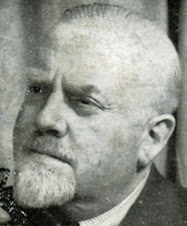








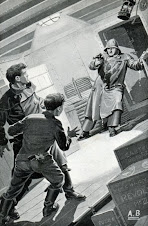
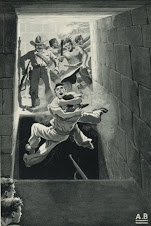





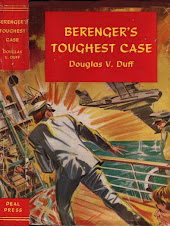





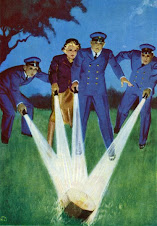
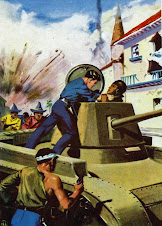
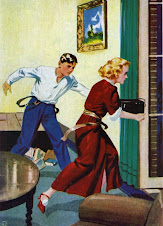
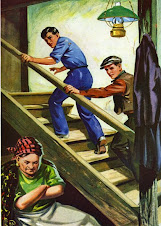









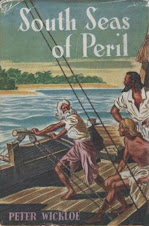



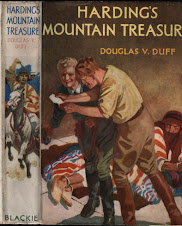
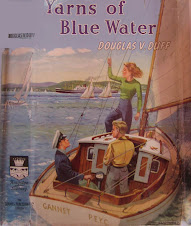

No comments:
Post a Comment